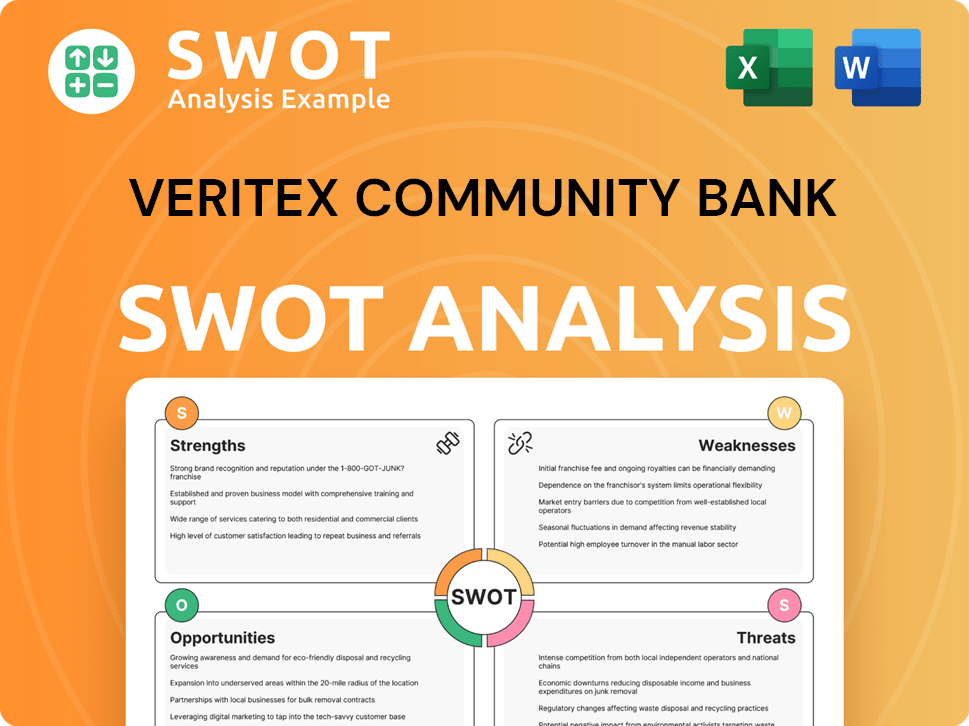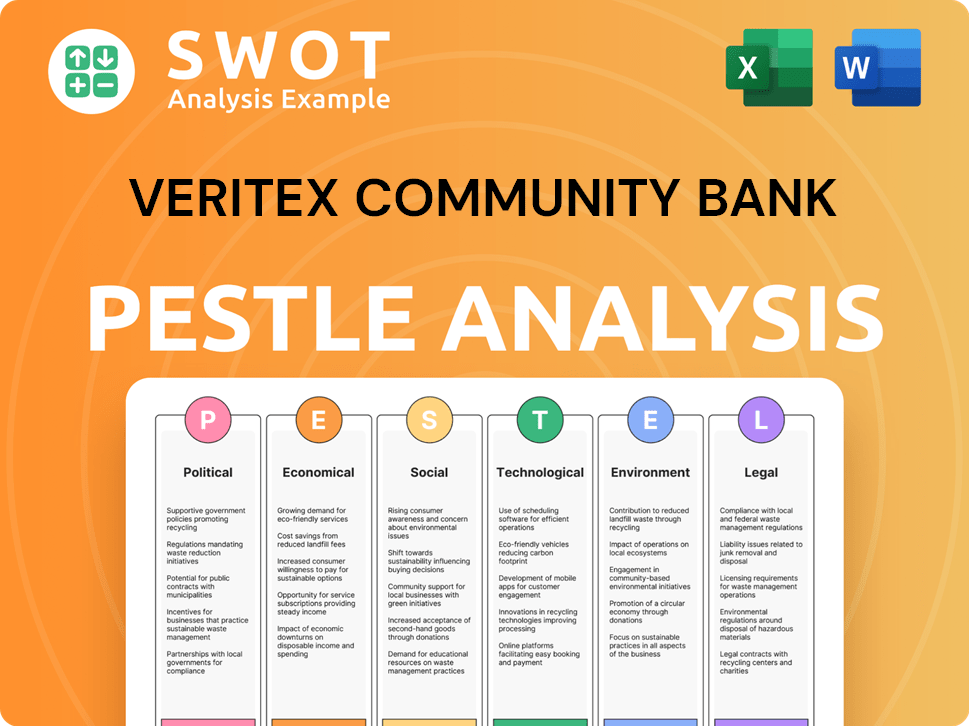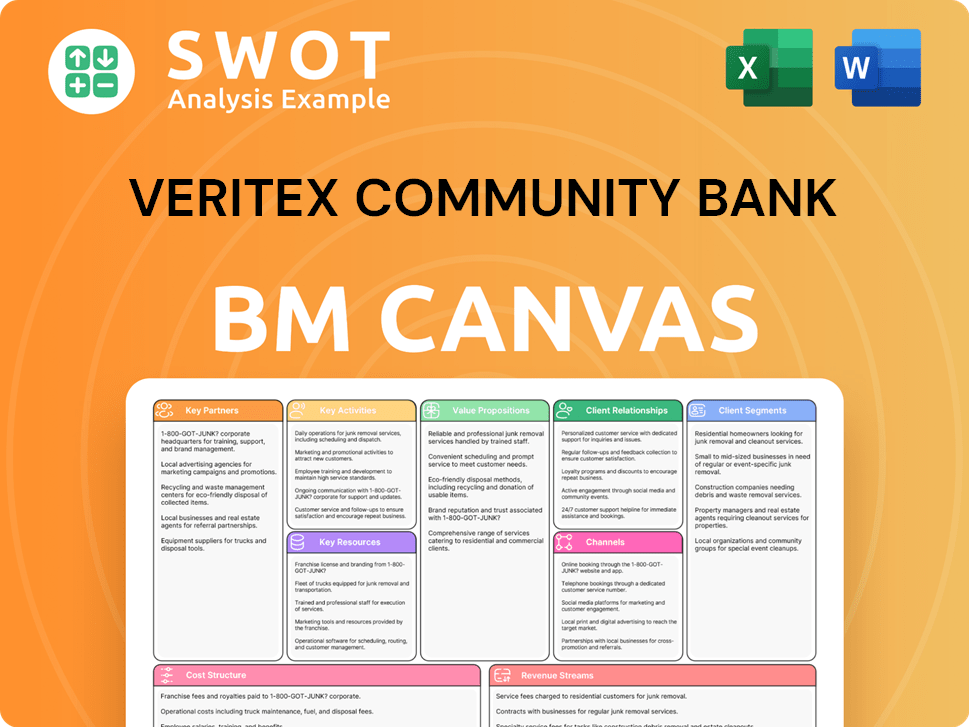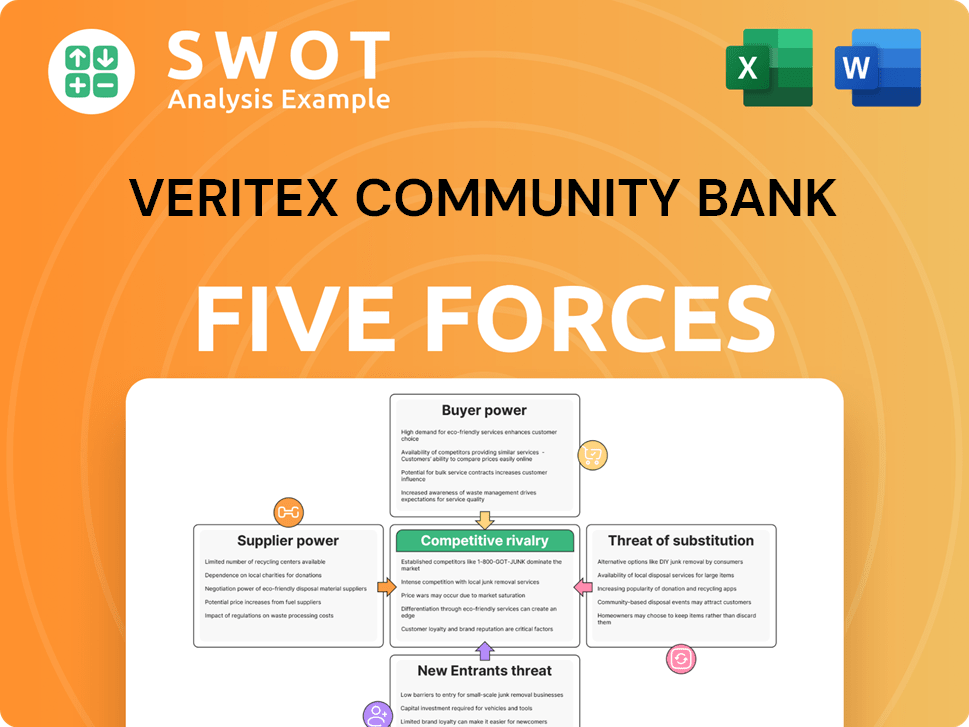Veritex Community Bank Bundle
How Does Veritex Community Bank Thrive in a Crowded Market?
In today's dynamic banking industry, understanding the competitive landscape is crucial for any financial institution's success. Veritex Community Bank, a key player in the Texas banking sector, offers a compelling case study. This analysis dives into the Veritex Community Bank SWOT Analysis, exploring its market position and how it navigates challenges.

Veritex Community Bank's competitive landscape is shaped by its regional presence and focus on personalized service, setting it apart from larger competitors. This detailed examination will identify Veritex competitors and assess its strategic advantages. Furthermore, we will explore its financial performance review, growth strategy, and how it maintains a strong customer base within the competitive Texas market, providing valuable insights for investors and industry analysts.
Where Does Veritex Community Bank’ Stand in the Current Market?
Veritex Community Bank holds a significant market position within the Texas banking industry, particularly in the Dallas-Fort Worth area. The bank's operations center around providing a comprehensive suite of financial products and services. These include deposit accounts, such as checking and savings, and a variety of loan products, including commercial real estate, commercial and industrial, and SBA loans.
The bank's value proposition centers on its community-focused approach, offering personalized service and local expertise. This strategy allows it to build strong relationships with its customers, particularly small and medium-sized businesses and affluent individuals. This focus differentiates it from larger national banks.
As of March 31, 2024, Veritex Holdings, Inc. (VBTX), the parent company, reported total assets of approximately $13.5 billion. This solidifies its position among the larger community banks in Texas. The bank strategically expands its physical branches and digital offerings to meet customer needs.
Veritex Community Bank's market share in Texas is substantial, especially within the Dallas-Fort Worth and Houston metropolitan areas. While exact figures for 2024-2025 are subject to ongoing reporting, the bank's asset size of $13.5 billion as of March 2024 indicates a strong position. This positions it as a key player in the competitive landscape.
The bank provides a wide range of services, including deposit products, such as checking and savings accounts, and various loan products. These include commercial real estate loans, commercial and industrial loans, and SBA loans. It also offers treasury management and other financial services tailored to its target segments.
Veritex's presence is primarily concentrated in Texas, with a strong focus on the Dallas-Fort Worth and Houston metropolitan areas. This regional focus allows for a deeper understanding of local market dynamics and customer needs. This geographical strategy is a key aspect of its community banking model.
The bank's financial health, as demonstrated by asset growth and consistent profitability, generally compares favorably to industry averages for community banks. This indicates a well-managed institution with a solid capital base. The bank's ability to attract and retain business clients highlights its strong market position.
Veritex Community Bank's competitive advantages include its community-focused approach, personalized service, and local expertise, which help it attract and retain business clients. The bank faces challenges from larger regional and national banks. These competitors have greater economies of scale and broader product portfolios.
- Strong regional presence in Texas, especially in Dallas-Fort Worth and Houston.
- Focus on providing personalized service to small and medium-sized businesses.
- Offers a comprehensive suite of deposit and loan products.
- Faces competition from larger banks with more resources.
Veritex Community Bank SWOT Analysis
- Complete SWOT Breakdown
- Fully Customizable
- Editable in Excel & Word
- Professional Formatting
- Investor-Ready Format

Who Are the Main Competitors Challenging Veritex Community Bank?
The Veritex Community Bank operates within a dynamic competitive landscape in Texas, contending with a variety of financial institutions. Understanding the Veritex Bank analysis involves examining its direct and indirect competitors, market position, and strategic responses to industry changes. The banking industry in Texas is particularly active, with numerous players vying for market share and customer loyalty.
Veritex Community Bank's ability to maintain and grow its market share depends on its competitive advantages and how it navigates the challenges posed by both regional and national banks, as well as emerging fintech companies. A thorough Veritex Community Bank competitive analysis is crucial for evaluating its strategic positioning and future outlook. The bank's performance is also influenced by broader Veritex Community Bank industry trends, including technological advancements and regulatory changes.
Veritex Community Bank faces competition from various financial institutions, each with its own strengths and strategies. Understanding the competitive dynamics is essential for assessing its market position and future prospects. The Veritex competitors range from local and regional banks to national powerhouses and fintech disruptors. Assessing the Veritex Community Bank market share analysis provides insights into its standing within the Texas banking sector.
Veritex Community Bank directly competes with other community and regional banks in Texas. These institutions often focus on similar customer segments and offer comparable banking services. They compete for the same customers by emphasizing local decision-making and community involvement.
Key regional players like Independent Financial and Texas Capital Bank are significant competitors. Texas Capital Bank, with a strong focus on commercial banking and wealth management, poses a challenge through its extensive corporate client base. Independent Financial offers similar services, competing for the same customer base.
Major national banks, including JPMorgan Chase, Bank of America, Wells Fargo, and Citibank, also compete with Veritex Community Bank. These banks have vast resources and offer a wide range of services, indirectly competing for larger business clients and affluent individuals. Their technological capabilities and product offerings are extensive.
Emerging fintech companies and online-only banks represent indirect competitors, particularly in digital payments and small business lending. These entities offer streamlined, technology-driven solutions that appeal to a younger, digitally-native demographic. Their agility and innovative approach challenge traditional banking models.
Comerica Bank, a larger national bank with a significant presence in Texas, competes with Veritex Community Bank, particularly in business banking. Comerica leverages its extensive branch network and diverse product offerings to attract businesses of all sizes. This impacts Veritex Community Bank's ability to attract and retain business clients.
Ongoing mergers and acquisitions within the banking sector influence the competitive landscape. These transactions can alter market share and introduce new competitive dynamics as institutions consolidate their strengths and expand their reach. This impacts Veritex Community Bank's strategic planning and market positioning.
Veritex Community Bank focuses on local decision-making, community involvement, and personalized customer service to differentiate itself. Its ability to offer tailored financial solutions and build strong relationships with its customers is a key competitive advantage. Understanding Veritex Community Bank's competitive advantages is crucial for assessing its market position.
- Local Focus: Emphasizing local decision-making and community involvement to attract and retain customers.
- Customer Relationships: Building strong relationships through personalized service and tailored financial solutions.
- Technology Adoption: Investing in digital banking and technology to enhance customer experience and operational efficiency.
- Strategic Partnerships: Forming partnerships to expand service offerings and reach new customer segments.
- Market Expansion: Targeting specific markets and customer segments for growth and increased market share.
Veritex Community Bank PESTLE Analysis
- Covers All 6 PESTLE Categories
- No Research Needed – Save Hours of Work
- Built by Experts, Trusted by Consultants
- Instant Download, Ready to Use
- 100% Editable, Fully Customizable

What Gives Veritex Community Bank a Competitive Edge Over Its Rivals?
Understanding the Veritex Community Bank's competitive landscape involves examining its strengths and how it differentiates itself within the banking industry. This analysis considers its market position, key strategies, and the factors that contribute to its success. Analyzing the Veritex Bank analysis is crucial for investors and stakeholders to gauge its potential and sustainability.
Veritex Community Bank has carved out a niche by prioritizing relationship-based banking and local market expertise. This approach allows for personalized service and quicker decision-making, especially beneficial for small and medium-sized businesses. The bank's focus on community engagement and customer success fosters high customer loyalty, driving consistent client retention and organic growth.
The bank's competitive advantages are rooted in its commitment to personalized service, local expertise, and strong community ties. These elements collectively contribute to its unique position in the market. For a deeper dive into the bank's strategic vision, consider reading about the Growth Strategy of Veritex Community Bank.
Veritex Community Bank excels in providing personalized service, fostering strong, long-term client relationships. This approach contrasts with the standardized interactions often found in larger institutions. The bank's focus on direct engagement with clients allows for tailored financial solutions and quicker responses to client needs.
The bank's strong ties within the Texas business community provide an invaluable network and understanding of local economic trends. This deep market knowledge enables Veritex Community Bank to better assess risks and identify opportunities. This local expertise allows for tailored product offerings, such as specialized commercial real estate loans or industry-specific financing.
Veritex Community Bank actively engages with the community, which cultivates a high degree of customer loyalty. This community-centric approach leads to consistent client retention and organic growth through referrals. The bank's culture, focused on community engagement and client success, sets it apart from larger competitors.
While Veritex Community Bank may not possess proprietary technologies on the scale of national banks, its strategic investments in digital banking platforms enhance customer convenience. These investments support the bank's ability to offer modern banking services while retaining its personalized touch. This blend of digital and personal service is a key differentiator.
Veritex Community Bank's competitive advantages are centered around its personalized service model, local market expertise, and strong community ties. These factors contribute to its ability to attract and retain customers. The bank's strategic investments in digital banking platforms further enhance customer convenience while maintaining a personalized touch.
- Personalized service fosters strong client relationships.
- Local expertise enables tailored financial solutions.
- Community engagement cultivates customer loyalty.
- Strategic digital investments enhance convenience.
Veritex Community Bank Business Model Canvas
- Complete 9-Block Business Model Canvas
- Effortlessly Communicate Your Business Strategy
- Investor-Ready BMC Format
- 100% Editable and Customizable
- Clear and Structured Layout

What Industry Trends Are Reshaping Veritex Community Bank’s Competitive Landscape?
The Veritex Community Bank faces a dynamic competitive landscape shaped by evolving banking industry trends and technological advancements. Its market position is influenced by its ability to adapt to digital transformation, regulatory changes, and shifting customer expectations. Understanding the current Veritex Bank analysis is crucial for assessing its future prospects and competitive strategies.
Veritex Community Bank's future outlook depends on its capacity to navigate challenges such as competition from fintech companies and economic uncertainties. Simultaneously, it must capitalize on opportunities like leveraging data analytics and forming strategic partnerships. A comprehensive understanding of the bank's strengths, weaknesses, opportunities, and threats – a Veritex Community Bank SWOT analysis – is essential for strategic planning and decision-making.
The banking industry is experiencing rapid technological advancements, with digital banking and AI reshaping service delivery. Regulatory changes, including those related to consumer protection, are also impacting operations. Customers increasingly expect personalized digital tools, necessitating adaptation in product development and marketing.
Balancing a high-touch model with technological demands is a key challenge for Veritex Community Bank. Competition from fintech companies and economic uncertainties, such as fluctuating interest rates, pose additional threats. Maintaining customer loyalty while expanding digital offerings is crucial for sustained success.
Leveraging strong customer relationships to cross-sell digital solutions presents a significant opportunity. Data analytics can provide deeper insights into customer behavior, enabling targeted financial products. Strategic partnerships with fintech firms can facilitate technological integration.
Veritex Community Bank is likely to adopt a hybrid strategy, combining technological enhancements with its core strengths in community engagement. This approach aims to solidify its competitive positioning within the Texas banking landscape. The recent article about Veritex Community Bank provides more details on the bank's strategy Owners & Shareholders of Veritex Community Bank.
Veritex Community Bank's success hinges on its ability to adapt and innovate within the evolving banking industry. Its Veritex competitors include both traditional banks and fintech companies, requiring it to continually assess its market position. Understanding these factors is critical for making informed decisions regarding Veritex Community Bank's growth strategy.
- Focus on digital transformation while preserving personalized customer service.
- Explore strategic partnerships to enhance technological capabilities.
- Use data analytics to improve customer targeting and product development.
- Monitor and adapt to changing regulatory requirements.
Veritex Community Bank Porter's Five Forces Analysis
- Covers All 5 Competitive Forces in Detail
- Structured for Consultants, Students, and Founders
- 100% Editable in Microsoft Word & Excel
- Instant Digital Download – Use Immediately
- Compatible with Mac & PC – Fully Unlocked

Related Blogs
- What are Mission Vision & Core Values of Veritex Community Bank Company?
- What is Growth Strategy and Future Prospects of Veritex Community Bank Company?
- How Does Veritex Community Bank Company Work?
- What is Sales and Marketing Strategy of Veritex Community Bank Company?
- What is Brief History of Veritex Community Bank Company?
- Who Owns Veritex Community Bank Company?
- What is Customer Demographics and Target Market of Veritex Community Bank Company?
Disclaimer
All information, articles, and product details provided on this website are for general informational and educational purposes only. We do not claim any ownership over, nor do we intend to infringe upon, any trademarks, copyrights, logos, brand names, or other intellectual property mentioned or depicted on this site. Such intellectual property remains the property of its respective owners, and any references here are made solely for identification or informational purposes, without implying any affiliation, endorsement, or partnership.
We make no representations or warranties, express or implied, regarding the accuracy, completeness, or suitability of any content or products presented. Nothing on this website should be construed as legal, tax, investment, financial, medical, or other professional advice. In addition, no part of this site—including articles or product references—constitutes a solicitation, recommendation, endorsement, advertisement, or offer to buy or sell any securities, franchises, or other financial instruments, particularly in jurisdictions where such activity would be unlawful.
All content is of a general nature and may not address the specific circumstances of any individual or entity. It is not a substitute for professional advice or services. Any actions you take based on the information provided here are strictly at your own risk. You accept full responsibility for any decisions or outcomes arising from your use of this website and agree to release us from any liability in connection with your use of, or reliance upon, the content or products found herein.